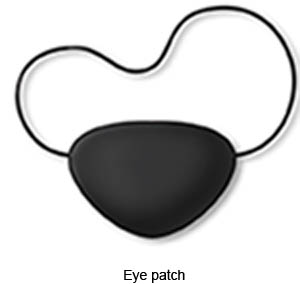WHAT YOU NEED TO KNOW: What is amblyopia in children? Amblyopia is a condition that causes your child to have poor vision. It occurs if your child's brain favors one eye instead of both eyes equally. This may cause him to have trouble seeing and understanding what he sees. He may not be able to see details very well. Amblyopia is sometimes called lazy eye because one eye is weaker than the other. What causes amblyopia in children? - Cataract: This happens if the lens of your child's eye gets cloudy and blocks some or all of the light entering his eye. This may cause your child to see dark or hazy images.
- Strabismus: Normally, both eyes move together and look at the same thing at the same time. Strabismus is a condition when the eyes do not move together. This may cause your child to see double.
- Error of refraction: This is when the lens of your child's eye cannot focus light waves very well. This may cause his vision to be blurry and unclear. This condition may occur in one or both eyes. When both eyes have different errors of refraction from each other, he may have a condition called anisometropia.
What are the signs and symptoms of amblyopia in children? Your child may have any of the following: - Eyes that are not aligned, or do not move together at the same time
- Poor vision, such as he cannot see objects waved in front of him
- One eye may drift and look away from the object in front of him
- He tilts his head to one side to see better
How is amblyopia in children diagnosed? Your child's healthcare provider will ask about your child's medical history and examine him. He may ask you if your child's head tilts to one side when he looks at things. He may ask if your child's eyes move together at the same time. Your healthcare provider may also use lenses and other instruments to examine your child's eyes. Your child may need any of the following tests: - Corneal light reflex test: This test uses light to see if your child's eyes are aligned, or looking at the same thing at the same time. Your child's healthcare provider will shine a light near your child's eyes. Your child's healthcare provider will look at the reflection on your child's eyes. Normally, the reflections should be at the same distance from his nose. If the reflections are not even, one of your child's eyes is not aligned.
- Cover-uncover test: This test also checks if your child's eyes are aligned. An object is placed across the room and your child's healthcare provider covers your child's eye. Your child's healthcare provider carefully looks at the uncovered eye for any movement. If the uncovered eye moves to look at the object, he may have amblyopia.
- Test for fixation: This test is used for children who cannot speak yet. In this test, your child's healthcare provider covers your child's eye. He waves a small flashlight in front of your child and watches how well your child follows the light. He repeats the test on the other eye and compares the results.
- Vision test: This test uses charts with letters, pictures, and shapes to check how well your child can see. Your child will be asked what he sees on a chart across the room. If your child cannot read or speak, your child's healthcare provider will look at your child's reactions when he holds up objects or charts.
How is amblyopia in children treated? Your child may need to wear eyeglasses to improve his vision. He may need eye surgery to correct a muscle imbalance in the eye. This will help the weak eye to see properly. Your child's healthcare provider will then cover the normal eye to allow the weak eye to develop and catch up. He may ask your child to wear an eye patch over the normal eye at certain times of the day. Your child's healthcare provider may suggest contact lens, eyeglasses, or medicine to blur vision in the normal eye. This forces the weak eye to see by itself so it will develop along with the normal eye. Your child's healthcare provider will do regular checkups to check the condition of both eyes. 
|
What are the risks of amblyopia in children? If eye medicine is used, it can cause irritation, redness of the skin, and headaches. The treatment to block vision in the normal eye may cause amblyopia in the normal eye. Even after treatment, your child's vision in the weak eye may return to the way it was before treatment. If left untreated, your child's vision may stay the same or it may worsen. Your child my lose vision in the weak eye. When should I contact my child's healthcare provider? - Your child has a fever.
- You have questions or concerns about your child's condition or care.
When should I seek immediate care or call 911? - Your child suddenly has trouble seeing, or cannot see at all.
- Your child's skin is itchy, swollen, or has a rash.
|